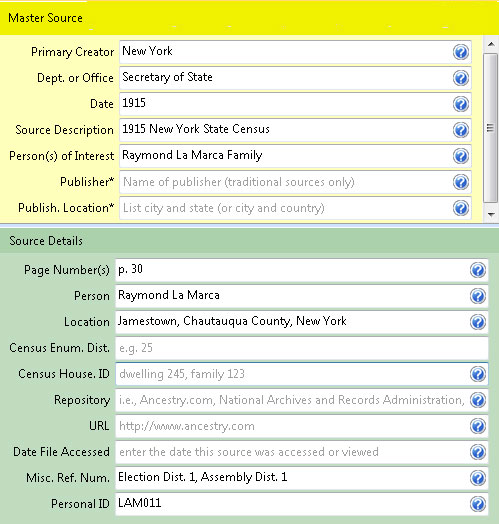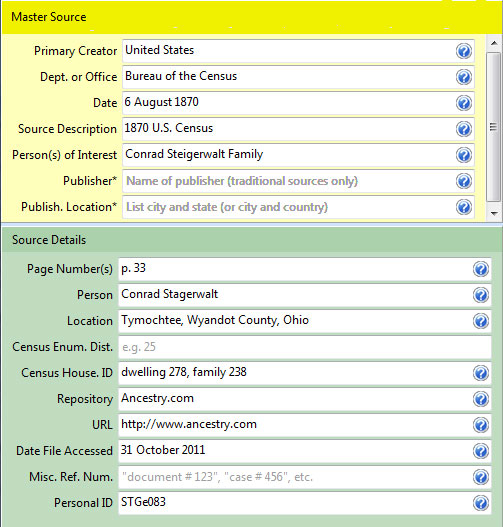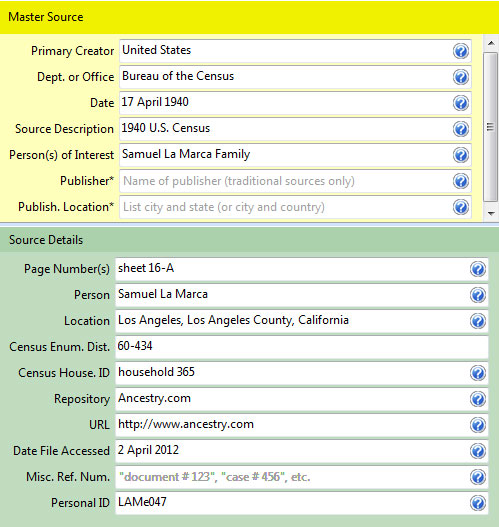Template Examples: Census
Most family historians will spend a considerable about of time dealing with census records. This template contains a total of 17 elements, three of which are REQUIRED (these are highlighted in red). The following describes each field and examples of census record entries are provided.
Master Source
- Primary Creator: Provide the name of the entity for which the census was created. More than likely, this will be the name of a country or state. This field is REQUIRED.
- Dept. or Office: Input the government agency or entity that was responsible for creating this census.
- Date: Enter the exact date that this census entry was created.
- Source Description: Provide the name of the specific census; "1940 U.S. Census" is appropriate, whereas "Fifteenth Census," while also appropriate, it is meaningless for many people.
- Person(s) of Interest: Census records often list families. In such cases, list the full name of the "head of household" followed by the word "Family." As this is part of the master source record, I will use the correct spelling of the surname, even when an incorrect spelling is listed on the census record.
- Publisher: Unless the census record has been reprinted, this field should be left blank. It is only used on the rare occasion that the census record had been obtained from a printed book, magazine, or other traditional source. Additional information, such as the information about a database, the appearance of an entity that has posted scans of the record (e.g., "Ancestry.com Operations, Inc."), or the year of publication should never be included in this field.
- Publisher Location: Again, this field should probably be left blank. A location would only be listed if the census record was obtained from a book or other printed source. If it is used, provide only the city and state (or city and country) where the book was published.
Source Details
- Page Number(s): The only information that should be listed here is the page number. If a "sheet number" is provided, then that may also be used (e.g., "sheet 1-B"). No other information should be listed.
- Person: List the name of the specific person that the citation refers to. I usually use the spelling found on the Census Record, even when it has been misspelled.
- Location: Enter the city, county, state, and country where this census was taken. (I do not list the country for U.S. census records as the country is implied by the presence of a state name.)
- Census Enumeration District: This is an optional field. I will include this information whenever possible, as it can be very helpful in assisting others to locate this same document.
- Census House. ID: Although it's possible to include the house or street address, only the dwelling and family number are needed (although I question if this information is really necessary; thus, it is optional).
- Repository: This is an optional field that should be used if this source was obtained over the Internet of if it's a one-of-a-kind document that is held in a private collection. If this document was obtained from a library or online service, it is not necessary to list the repository.
- URL: Although the full URL may be appropriate, listing only the home page of sites where a document is located (e.g., http://www.ancestry.com) is sufficient, as many of these, particularly those are from commercial sites that require subscriptions; listing the full URL from commercial sites will not be useful to those who don't subscribe.
- Date File Accessed: This is another optional field that I only use to cite sources that were obtained on the Internet. In all other cases, it should be left blank.
- Misc. Ref. Num.: I have now used Simple Citations for more than ten years and have used this field on only a few occasions. Use this field sparingly.
- Personal ID: The information placed in this field refers to the personal numbering system you use to organize your family history. This information should never be printed on reports or in your citations. It is only used to help you keep track of your documentation.



